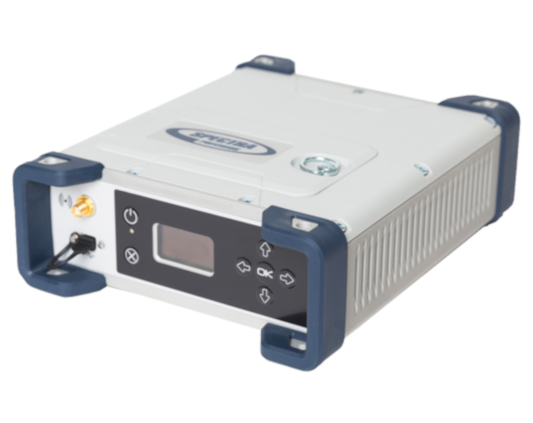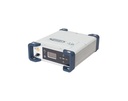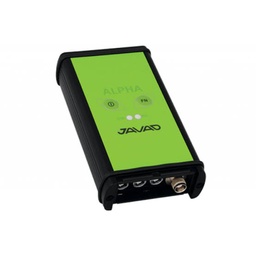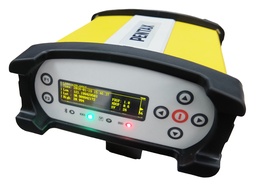GNSS ENGINE
480 GNSS tracking channels
GPS L1 C/A, L1P (Y), L2P (Y), L2C, L5, L1C
GLONASS L1 C/A, L1P, L2 C/A, L2P, L3, L1/L2 CDMA 1
GALILEO E1, E5a, E5b, E6
BeiDou B1, B2, B3 1
QZSS L1 C/A, L1s, L1C, L2C, L5
IRNSS L5
SBAS L1 C/A, L5
Two MSS L-band tracking channels
Two GNSS antenna inputs 2
FEATURES
Patented Z-tracking to track encrypted GPS P(Y) signal
Patented Strobe™ Correlator for reduced GNSS multipath
Patented Z-Blade technology for optimal GNSS performance:
Highest quality of raw data (availability/reliability) to meet reference station applications
Full utilization of signals from all seven GNSS systems (GPS, GLONASS, BeiDou, Galileo, QZSS, IRNSS, and SBAS)
Enhanced GNSS-centric algorithm: fully-independent GNSS signal tracking and optimal data processing, including GPS-only, GLONASS-only or BeiDou-only solution (from Autonomous to full RTK) 3
Fast and stable RTK solution
Fast Search engine for quick acquisition and re-acquisition of GNSS signals
Patented SBAS ranging for using SBAS code & carrier observations and orbits in RTK processing
Position in local datums and projections with RTCM-3 transformation data
Support for Trimble RTX™ real-time correction services
Support for CenterPoint® RTX Post-processing service
UHF networking
Hot Standby RTK Algorithms
Flying RTK Algorithms
RTK base and rovers modes, post-processing mode
Moving base
RTK with Static & Moving Base corrections supported
Multi-dynamic mode (static/moving Base and Rover functions simultaneously)
RTK against a moving base for relative positioning
Heading and Roll/Pitch
Accurate and fast heading using dual frequency multi-GNSS algorithms
RTK or Trimble RTX and heading processingsimultaneously
Heading engine with optional baseline length self-calibration
Adaptive velocity filter to meet specific dynamic applications
Up to 50 Hz real-time raw data (code & carrier and position, velocity, and heading output) 4
Reference Inputs/Outputs: RTCM 3.2 5, RTCM 3.1/3.0/2.3/2.1, CMR/CMR+ 6, ATOM 7
RTK Networks Supported: VRS, FKP, MAC
NTRIP protocol
Navigation Outputs: NMEA-0183, ATOM
PPS output
Event marker input
One-push Ashtech Trouble Log (ATL)
GNSS SENSOR PERFORMANCE
Time to First Fix (TTFF):
Cold start: < 60 seconds
Warm Start: < 45 seconds
Hot Start: < 11 seconds
Signal re-acquisition: < 2 seconds
Position accuracy (HRMS), SBAS: < 50 cm (1.64 ft) 8
Update rate: Up to 50 Hz 4
Latency: < 10 ms 9
Velocity Accuracy: 0.02 m/sec HRMS
Maximum Operating Limits 10:
Velocity: 515 m/sec
Altitude: 18,000 m
PRECISE POSITIONING PERFORMANCE
Real-Time Accuracy (RMS) 11, 12
Real-Time DGPS Position:
Horizontal: 25 cm (0.82 ft) + 1 ppm
Vertical: 50 cm (1.64 ft) + 1 ppm
Real-Time Kinematic Position (RTK):
Horizontal: 8 mm (0.026 ft) + 1 ppm
Vertical: 15 mm (0.049 ft) + 1 ppm
Network RTK 13:
Horizontal: 8 mm (0.026 ft) + 0.5 ppm
Vertical: 15 mm (0.049 ft) + 0.5 ppm
Trimble RTX™ (satellite and cellular/Internet (IP)) 14, 15
CenterPoint® RTX
Horizontal (RMS): < 4 cm
Initialization: < 30 min. (typical)
Operating range (inland): Nearly worldwide
CenterPoint RTX Fast
Horizontal (RMS): < 4 cm
Initialization: < 5 min. (typical)
Operating range (inland): In select regions
Heading 16, 17, 18
Accuracy (RMS):
0.09° @ 2 m of baseline length
0.02° @ 10 m of baseline length
Initialization time: < 10 sec typical
Baseline length: < 100 m
Flying RTK
5 cm (0.165 ft) + 1 ppm (steady state) horizontal for baselines up to 1000 km
Real-Time Performance 11, 12
Instant-RTK® Initialization:
Typically 2-second initialization for baselines < 20 km
Up to 99.9% reliability
RTK initialization range:
> 40 km
Post-Processing Accuracy (RMS) 11, 12
Static, Rapid Static:
Horizontal: 3 mm (0.009 ft) + 0.5 ppm
Vertical: 5 mm (0.016 ft) + 0.5 ppm
High-Precision Static 19:
Horizontal: 3 mm (0.009 ft) + 0.1 ppm
Vertical: 3.5 mm (0.011 ft) + 0.4 ppm
Post-Processed Kinematic:
Horizontal: 8 mm (0.026 ft) + 0.5 ppm
Vertical: 20 mm (0.065 ft) + 1.0 ppm
Data Logging Characteristics
Recording Interval: 0.02 20 - 999 seconds
Memory
8 GB internal memory
Memory is expandable through external USB sticks or hard drives
Over four years of 15 sec. raw GNSS data from 14 satellites (logged to internal 8 GB Nand Flash)
Embedded Web Server
Password-protected Web Server
Full receiver monitoring and configuration
FTP push function
Embedded FTP server and NTRIP caster 21
NTRIP Server and instant real-time multi-data streaming over Ethernet
DHCP or manual configuration (static IP address)
DynDNS® technology support
USER AND I/O INTERFACE
User Interface
Graphical OLED display with 6 keys and 1 LED
WEB UI (accessible via WiFi) for easy configuration, operation, status and data transfer
I/O Interface:
1 x USB OTG
Bluetooth v4.0 + EDR/LE, Bluetooth v2.1 + EDR
WiFi (802.11 b/g/n)
3.5G quad-band GSM (850/900/1800/1900 MHz) / penta-band UMTS module (800/850/900/1900/2100 MHz)
1 x Ethernet, RJ45 (Full-Duplex, auto-negotiate 10 Base-TX / 100 Base-TX)
1 x Lemo, RS232 (radio connection and external power)
1 x DB9, RS232 (PPS output and CAN bus)
1 x DB9, RS422/232 (Event marker input)
2 x TNC, GNSS antenna input
1 x TNC, UHF radio antenna connector
1 x SMA, GSM antenna connector
1 x SMA, Bluetooth/WiFi antenna
PPS output
Event marker input
Galvanic Insulation (Except USB)
Ready for CAN bus (NMEA2000 compatible)
PHYSICAL AND ELECTRICAL CHARACTERISTICS
Size: 16.5 x 20.6 x 6.5 cm (6.5 x 8.1 x 2.6 in)
Weight: GNSS receiver: 1.66 kg (3.66 lb) without UHF / 1.70 kg (3.75 lb) with UHF
Battery life:
4 hrs (RTK Base, GNSS On, UHF Tx On), 12.8 W average power consumption
6 hrs (RTK Rover, GNSS On, UHF Rx On), 5.9 W average power consumption
Li-ion battery, 27.8 Wh (7.4 V x 3.7 Ah). Acts as a UPS in case of a power source outage
9-36 V DC input (EN2282, ISO7637-2)
External DC power limits feature
ENVIRONMENTAL CHARACTERISTICS
Operating temperature 22: -40° to +65°C 23 (-40° to +149°F)
Storage temperature 24: -40° to +95°C (-40° to +203°F)
Humidity: Damp heat 100% humidity, +40°C (+104°F), IEC 60945:2002
IP67 (waterproof and dustproof), IEC 60529
Drop: 1m drop on concrete
Shock: MIL STD 810F (fig. 516.5-10) (01/2000), Sawtooth (40g / 11ms)
Vibration: MIL-STD 810F (fig. 514.5C-17) (01/2000)
Product is designed to fully support GLONASS L1/L2 CDMA and BeiDou B3 signals as soon as the officially published signal Interface Control Documentations (ICD) become available.
Dual-frequency tracking only from secondary GNSS antenna input.
All available GNSS signals are processed equally and combined without preference to any particular constellation for optimal performance in harsh
environments.
50 Hz output is available as firmware option (20 Hz output is a standard feature). At 50 Hz, a limited set of messages can be generated simultaneously through a single port.
RTCM-3.2 Multiple Signal Messaging (MSM) guarantees compatibility with 3rd party for each GNSS data.
A Trimble proprietary format.
ATOM: Open Ashtech format.
VRMS for Autonomous/SBAS positions are usually twice as high as HRMS.
Heading latency is usually twice as high.
As required by the U.S. Department of Commerce to comply with export licensing restrictions.
Accuracy and TTFF specifications may be affected by atmospheric conditions, signal multipath and satellite geometry.
Performance values assume minimum of five satellites, following the procedures recommended in the user guide. High multipath areas, high PDOP values and periods of severe atmospheric conditions may degrade performance.
Network RTK PPM values are referenced to the closest physical base station.
Requires L1/L2 GPS+GLONASS at a minimum.
Accuracy and TTFF specifications may be affected by atmospheric conditions, signal multipath, satellite geometry and L-band service availability. Trimble RTX correction services are only available on land.
Accuracy and TTFF specifications may be affected by atmospheric conditions, signal multipath, satellite geometry and corrections availability
and quality.
L1/L2 data required.
Figures of pitch accuracy are twice as high.
Depending on baselines, precise ephemeris and long occupations up to 24 hrs may be required to achieve the high precision static specifications.
A Recording Interval of 0.05 is based on a 20 HZ output. The default changes to 0.02 if the optional 50 Hz output firmware option is installed.
Embedded NTRIP Caster is available as firmware option.
Function of the configuration is:
Charging mode with internal battery at +45°C (+113°F) max.
Discharge mode with internal battery at +60°C (+140°F)
Without internal battery (external power supply) at +65°C (+149°F) under conditions of installation.
At very high temperature, the UHF module should not be used in transmitter mode. With the UHF transmitter on radiating 2W of RF power, the operating temperature is limited to + 55°C (+131°F).
At this temperature, hand protection may be needed to safely handle the system’s lower aluminum housing (as per EN60945).
Without battery. Battery can be stored up to +70°C (+158°F).
NOTE: All performance values are given assuming a minimum of five satellites are used, and following the procedures recommended in the user guide. High multipath areas, high PDOP values and periods of severe atmospheric conditions may degrade performance.












![[SA1800] SA1800 Antenna (Stonex)](/web/image/product.product/544/image_256/%5BSA1800%5D%20SA1800%20Antenna%20%28Stonex%29?unique=2b0c7be)
![[SC2200] Stonex SC2200 GNSS receiver](/web/image/product.product/545/image_256/%5BSC2200%5D%20Stonex%20SC2200%20GNSS%20receiver%20?unique=a1976d3)